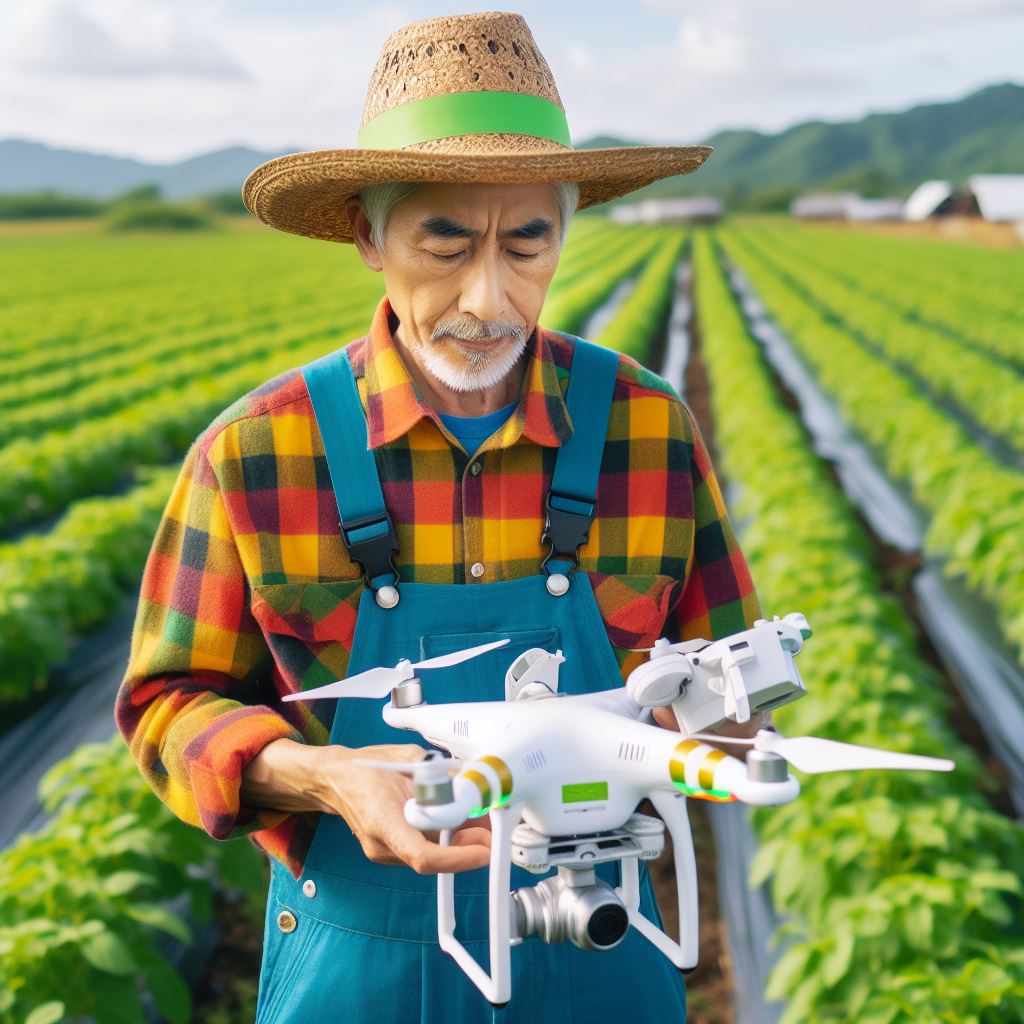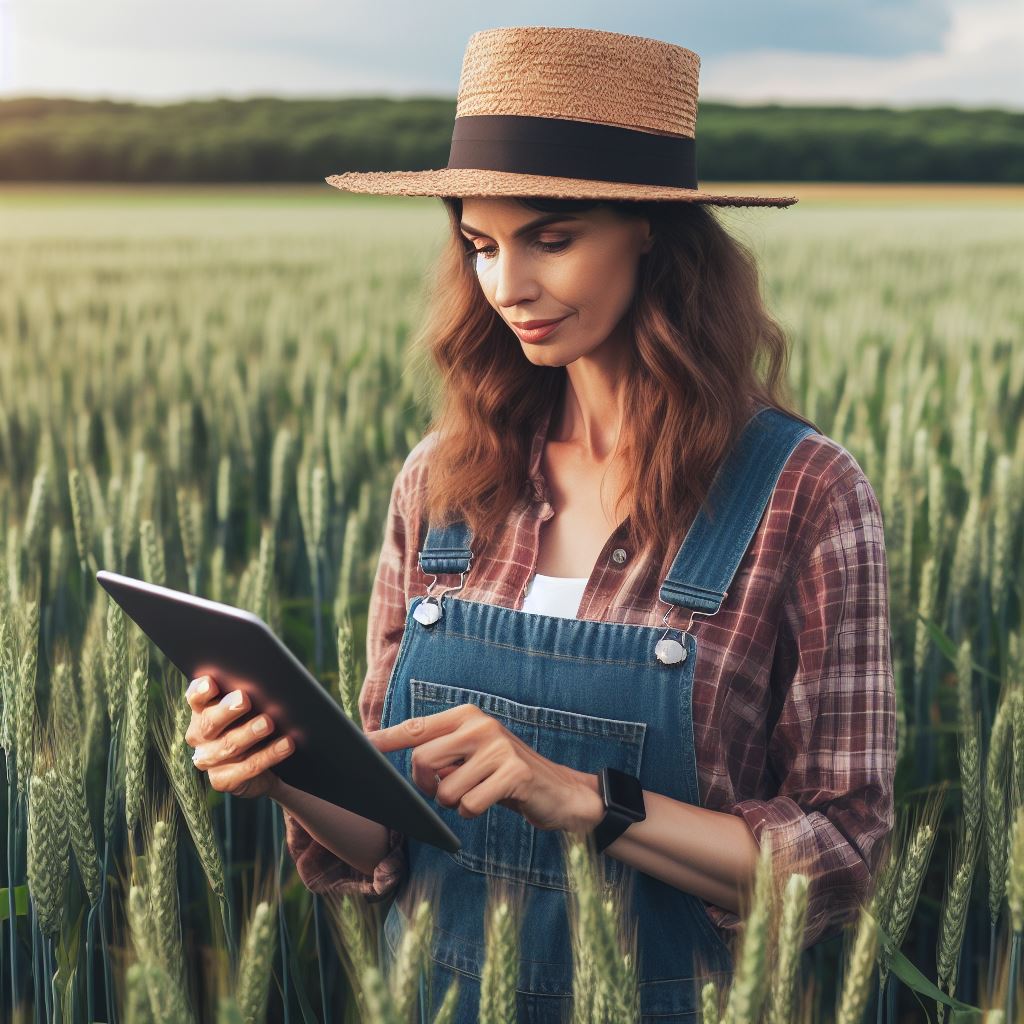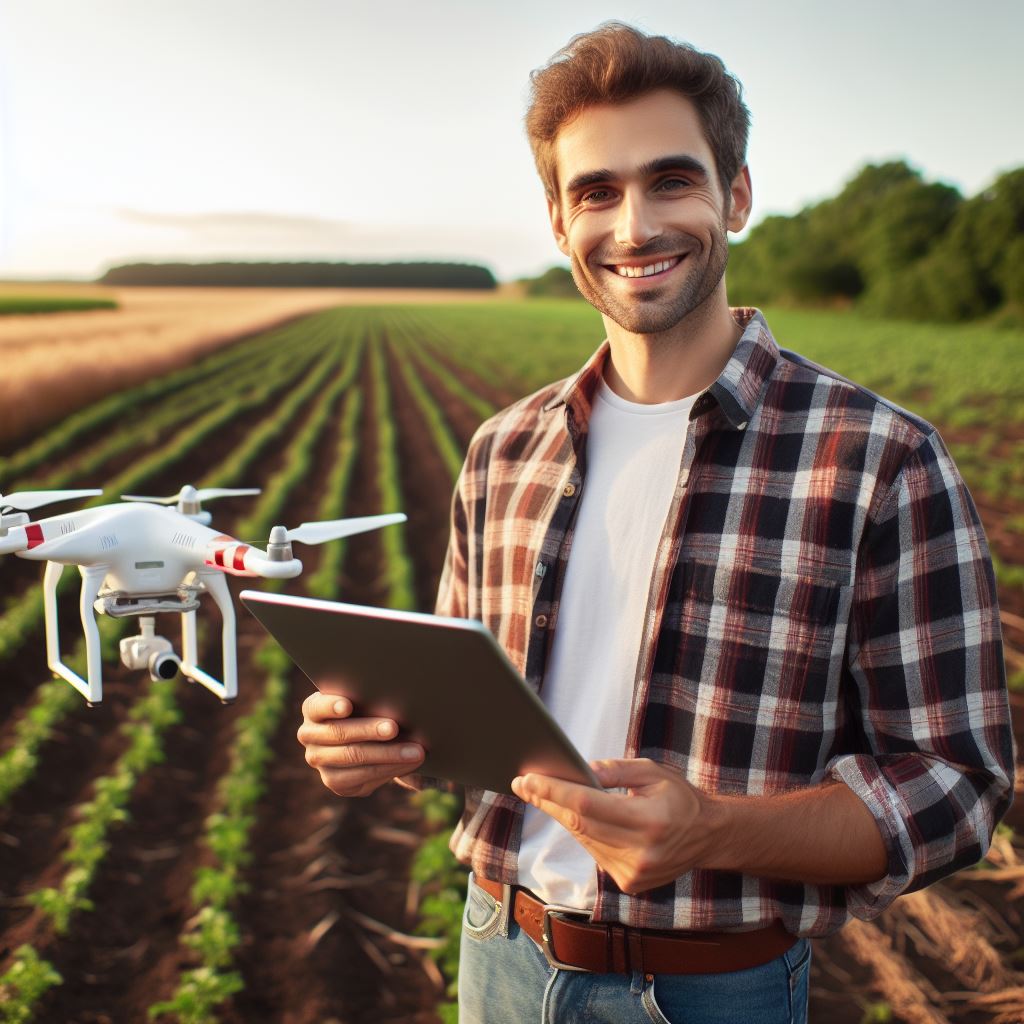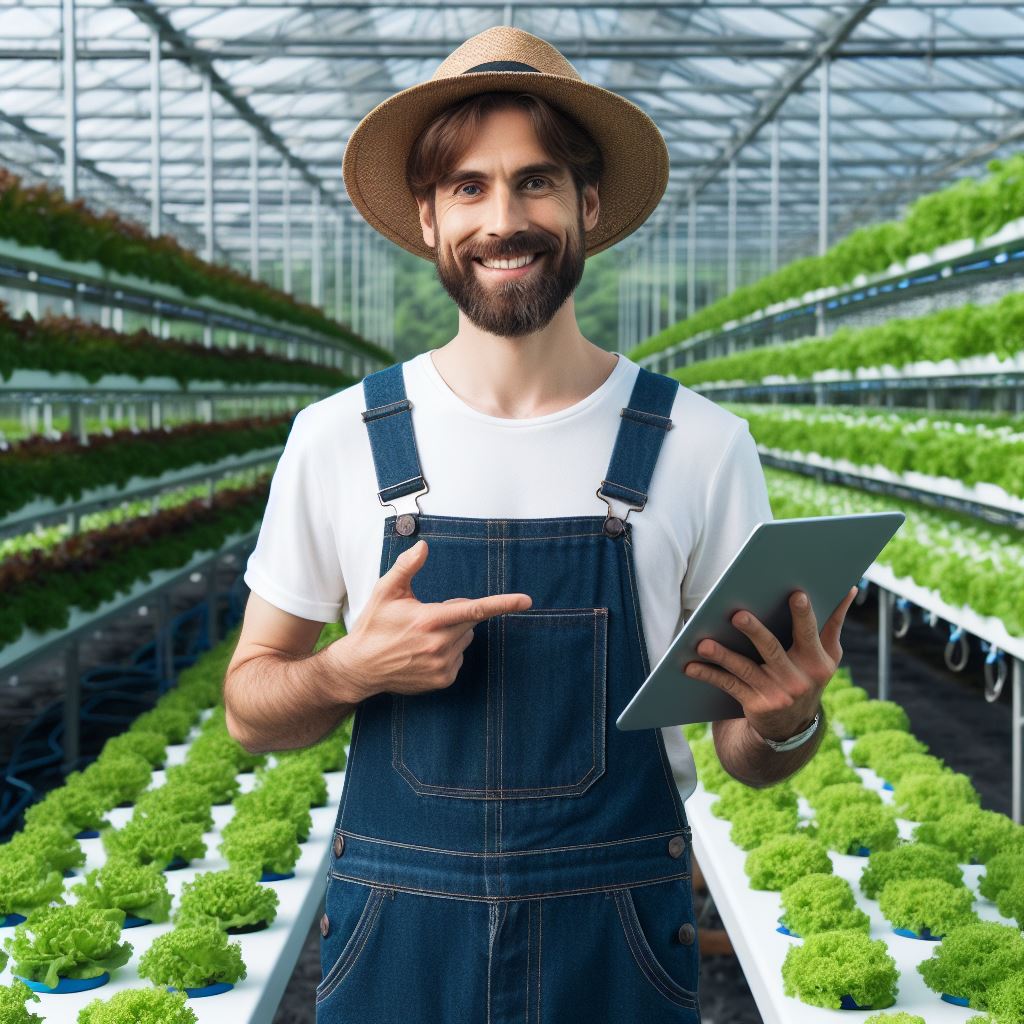Introduction
Drones, unmanned aerial vehicles, are flying devices controlled remotely.
Technology has revolutionized many industries, including agriculture.
Drones are now playing a crucial role in transforming agricultural practices.
Drones in Agriculture: A Revolutionary Tool
The drone technology has emerged as a game-changer in the agricultural sector, providing numerous benefits to farmers.
Their ability to collect real-time data and perform tasks efficiently is transforming the industry.
Improved Crop Monitoring and Analysis
Drones equipped with high-resolution cameras and sensors can capture detailed images of crops.
These images assist farmers in monitoring plant health and identifying issues like pest infestations or nutrient deficiencies.
- Precision Agriculture: The use of drones enables precise application of fertilizers, pesticides, and water. This accurate and targeted approach saves resources, reduces environmental impact, and optimizes crop production.
- Crop Spraying: Traditionally, spraying chemicals was a time-consuming and labor-intensive task. Drones equipped with spraying systems can precisely apply fertilizers or pesticides, ensuring uniform coverage, reducing human exposure to chemicals, and minimizing drift.
- Livestock Monitoring and Management: Drones can monitor and count livestock, allowing farmers to assess animal behavior, track their movements, and identify potential health issues. This technology improves animal welfare and overall farm management.
- Crop Mapping and Planning: By capturing high-resolution images and data, drones provide farmers with precise crop mapping. Farmers can analyze this information to plan crop rotation, irrigation strategies, and optimize land use.
Drones are revolutionizing the agricultural industry by providing efficient and cost-effective solutions.
With the ability to monitor crops, spray chemicals, manage livestock, and assist in crop planning, drones are transforming agricultural practices for a more sustainable and productive future.
The Benefits of Drones in Agriculture
Drones are revolutionizing traditional farming methods by providing numerous benefits to the agricultural industry.
- Increased efficiency and accuracy in crop monitoring and assessment: Drones equipped with sensors and cameras can capture high-resolution images and collect data on crop health, growth patterns, and potential issues. This enables farmers to identify problem areas and take necessary actions promptly.
- Improved crop spraying and precision agriculture practices: Drones can spray fertilizers, pesticides, and herbicides with precision, reducing wastage and ensuring targeted application. This not only minimizes the environmental impact but also increases the effectiveness of these inputs.
- Reduction in manual labor and costs associated with traditional methods: Drones can autonomously perform tasks that would otherwise require manual labor, such as crop monitoring, mapping, and spraying. This saves both time and money for farmers.
- Enhanced data collection and analysis: Drones can quickly gather large amounts of data from various parts of a farm, allowing for better decision-making and optimized resource allocation. The data collected can be analyzed to identify trends, patterns, and potential improvements.
- Precision mapping and field management: Drones equipped with GPS technology can create accurate maps of fields, helping farmers monitor changes in crop health, water levels, and soil conditions. This information enables targeted interventions and overall better field management.
Additional benefits
- Early detection of crop diseases and pests: With advanced imaging systems, drones can detect signs of diseases, pests, or nutrient deficiencies in crops at early stages. This helps farmers take immediate action and prevent the spread of such issues.
- Efficient livestock management: Drones can be used to monitor and manage livestock by gathering data on their location, behavior, and overall health. This allows farmers to address potential issues quickly and optimize their livestock management practices.
- Reduced environmental impact: Drones facilitate targeted interventions, such as precise spraying, leading to a significant reduction in the use of chemicals and fertilizers. This minimizes environmental pollution and promotes sustainable farming practices.
- Remote and difficult terrain accessibility: Drones can access remote and challenging terrains that are otherwise difficult to reach. They can provide vital information about these areas, enabling farmers to make informed decisions regarding cultivation and resource utilization.
In general, drones are transforming agricultural practices by offering benefits such as increased efficiency, improved precision, reduced labor and costs, enhanced data collection and analysis, and better environmental practices.
By adopting drone technology, farmers can optimize their operations, improve yields, and contribute to sustainable agriculture.
Read: Precision Agriculture: How Drones Change the Game
Applications of Drones in Agricultural Practices
Crop monitoring and assessment
- Drones provide aerial imagery and analyze crop health, assisting farmers in assessing their crops.
- Identification of pest and disease infestations in crops is made easier and more efficient through drone technology.
- Drones enable early detection of irrigation and water stress, helping farmers optimize their water usage.
Crop spraying and precision agriculture
- Drones allow for the precise application of fertilizers, herbicides, and pesticides, minimizing waste and maximizing effectiveness.
- Targeted spraying using drones minimizes the environmental impact of agrochemicals by reducing their overall usage.
- Automated farm management and data analysis through drone data helps farmers make informed decisions.
Drones have revolutionized various sectors, and agriculture is no exception.
With their ability to fly over fields and capture aerial imagery, drones have become invaluable tools in agricultural practices.
Transform Your Agribusiness
Unlock your farm's potential with expert advice tailored to your needs. Get actionable steps that drive real results.
Get StartedThey offer numerous applications that help farmers monitor, assess, and manage their crops efficiently.
Crop monitoring and assessment
Aerial imagery and crop health analysis using drones
One of the key applications of drones in agriculture is crop monitoring and assessment.
By capturing aerial images, drones enable farmers to monitor the health and growth of their crops more accurately.
These aerial images, combined with advanced image analysis techniques, provide valuable insights into crop health.
Farmers can detect diseases, pests, and nutrient deficiencies early on, allowing for appropriate interventions and minimizing crop loss.
Early identification of irrigation and water stress
Drones equipped with infrared cameras can even assess the overall health of plants by measuring their thermal signature.
This allows farmers to identify crop stress caused by insufficient irrigation or excessive heat.
By promptly addressing such issues, farmers can optimize water usage and prevent yield losses.
Crop spraying and precision agriculture
Precision application of fertilizers, herbicides, and pesticides
Another significant application is crop spraying and precision agriculture.
Traditional methods of crop spraying often involve blanket spraying, leading to the excessive use of agrochemicals and potential environmental consequences.
Drones equipped with onboard spraying systems enable precise application of fertilizers, herbicides, and pesticides.
They can be programmed to precisely target specific areas or individual plants, reducing the overall amount of chemicals required while maximizing their efficacy.
Automated farm management and data analysis using drone data
Additionally, drones play a vital role in automated farm management and data analysis.
By collecting high-resolution imagery and other sensor data, drones generate valuable information for farmers.
This data, combined with advanced analytics and machine learning algorithms, helps farmers make data-driven decisions.
They can efficiently plan crop rotations, optimize resource allocation, and identify areas that require attention.
Furthermore, drones can provide real-time monitoring, allowing for early identification of potential issues and timely interventions.
Overall, the integration of drones in agricultural practices has transformed the way farmers manage their crops.
The ability to monitor crop health, detect infestations, and assess irrigation stress from above offers unique advantages.
Precision spraying reduces chemical usage and minimizes environmental impacts.
Automated data analysis supports smarter decision-making and enhances overall farm management.
As drone technology continues to advance, it is expected that their applications in agriculture will expand further.
With the ability to cover vast areas efficiently, drones have the potential to revolutionize farming practices worldwide.
They facilitate sustainable agriculture by reducing chemical usage, optimizing resource allocation, and enhancing productivity.
Showcase Your Farming Business
Publish your professional farming services profile on our blog for a one-time fee of $200 and reach a dedicated audience of farmers and agribusiness owners.
Publish Your ProfileThe future of agriculture lies in harnessing the power of drones, ultimately transforming agricultural practices for the better.
Read: Drones in Agriculture: The Future of Farming
Case Studies and Success Stories
Farms utilizing drones for crop yield improvement
Smith Family Farms
Smith Family Farms, located in Iowa, has successfully implemented drone technology to monitor crop health and identify areas that require additional attention.
By capturing high-resolution images of the fields, the drones provide real-time data that helps farmers optimize their irrigation and fertilizer usage.
As a result, Smith Family Farms has seen a 15% increase in crop yields while reducing water consumption by 20%.
The accurate monitoring provided by the drones has also enabled them to detect early signs of disease or pest infestations, preventing further damage and reducing the need for chemical intervention.
Green Acres Farms in California
Another example is Green Acres Farms in California, which has been using drones equipped with thermal cameras to monitor the temperature and moisture levels of their crops.
This data is then combined with satellite imagery and weather forecasts to create precise irrigation schedules.
By optimizing their irrigation practices, Green Acres Farms has witnessed a 30% reduction in water usage while maintaining healthy crop growth.
The cost savings on water bills and the environmental benefits have been substantial.
Examples of cost-saving and increased productivity through drone use
Harvest Haven Farms
Harvest Haven Farms deployed drones to monitor the health and growth of their livestock more effectively.
By utilizing aerial cameras, farmers can quickly identify sick or injured animals, reducing the time spent searching for them.
This efficient process minimizes labor costs and ensures timely treatment of sick animals, resulting in higher survival rates and improved overall herd health.
The data collected from the drones also allows for targeted grazing management, optimizing pasture utilization and reducing feed expenses.
The increased productivity and cost savings have made a significant impact on Harvest Haven Farms’s profitability.
Meadowbrook Orchards
Moreover, Meadowbrook Orchards has implemented drones for spraying pesticides on their crops, replacing traditional manual labor.
The drones can precisely apply chemicals in a controlled manner, reducing waste and minimizing human exposure to potentially harmful substances.
This approach not only saves time but also lowers the production costs associated with manual labor and decreases the need for chemical inputs.
Meadowbrook Orchards has reported a 25% reduction in pesticide expenses while maintaining high crop quality, leading to increased profits.
Testimonials from farmers and agricultural experts
John Smith
John Smith, a farmer with over 20 years of experience, expresses his satisfaction with integrating drones into his agricultural practices.
According to him, drones have revolutionized the way he manages his farm.
The ability to monitor his crops from above, analyze the data received, and take necessary action has significantly improved efficiency and productivity.
He believes that drones have not only saved him valuable time and money but also allowed him to make informed decisions based on accurate real-time data.
Dr. Emily Davis
Dr. Emily Davis, an agricultural expert, emphasizes the positive impact of drones on the industry.
She mentions that drones have transformed the way farmers approach crop management, enabling precise and targeted interventions.
The ability to detect potential issues at an early stage, such as nutrient deficiencies or crop diseases, helps farmers take corrective measures promptly, leading to improved crop health and higher yields.
Dr. Davis believes that drones have the potential to revolutionize modern agriculture and help farmers overcome various challenges.
By showcasing these case studies and success stories, it is evident that drones have become an invaluable tool for transforming agricultural practices.
Farmers and agricultural experts have witnessed significant improvements in crop yields, cost savings, and overall productivity.
The integration of drone technology has revolutionized how they monitor crops, manage livestock, and optimize resources.
With its ability to provide real-time data and insights, drones have proven to be a game-changer in the agriculture industry.
Read: Revolutionizing Farms: Drones in Crop Monitoring
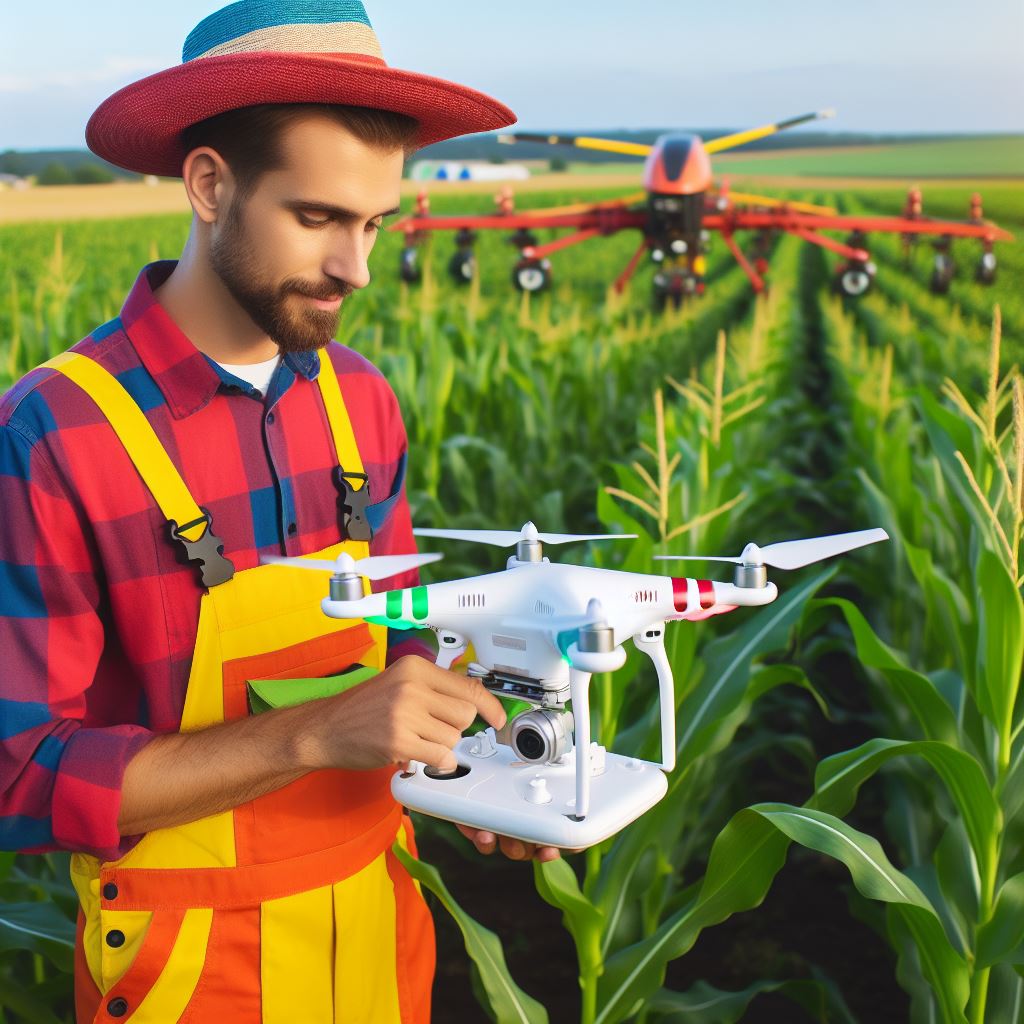
Challenges and Limitations
Drones are revolutionizing agricultural practices, offering numerous benefits and opportunities for farmers.
However, their implementation also faces several challenges and limitations that need to be addressed.
Regulations, permissions, and legal barriers for drone operation
One of the primary concerns associated with drone use in agriculture is the regulatory framework.
Governments have implemented strict regulations and legal barriers for drone operation.
Farmers must comply with these rules, obtain appropriate permissions, and adhere to flight restrictions.
Failure to do so can result in penalties and fines, hampering the widespread adoption of drones in agriculture.
Drone affordability and accessibility for small-scale farmers
Furthermore, drone affordability and accessibility pose significant challenges, particularly for small-scale farmers.
The initial investment required to purchase high-quality drones, along with the necessary equipment and software, can be substantial.
Showcase Your Farming Business
Publish your professional farming services profile on our blog for a one-time fee of $200 and reach a dedicated audience of farmers and agribusiness owners.
Publish Your ProfileThis financial hurdle prevents many farmers from utilizing drones to enhance their agricultural practices.
It is crucial to make drones more affordable and accessible, enabling all farmers, regardless of farm size, to benefit from their capabilities.
Privacy and data security concerns
Additionally, privacy and data security concerns surround the use of drones in agriculture.
Drones collect vast amounts of data, including aerial imagery, crop health, and soil conditions.
This data is crucial for making informed decisions and improving agricultural productivity.
However, there is a need to address concerns about who has access to this data, how it is stored, and the potential risks of data breaches or misuse.
Implementing robust data protection measures and establishing clear guidelines for data ownership and usage are essential to alleviate these concerns.
Overcoming these challenges
To overcome these challenges and limitations, collaboration between stakeholders is critical.
Governments should proactively manage regulations to strike a balance between ensuring safety and enabling drone utilization in agriculture.
They should streamline the permission processes and provide support to farmers in navigating the legal framework.
Drone affordability and accessibility for small-scale farmers
Moreover, it is essential to focus on making drones more affordable and accessible.
Governments, agricultural organizations, and technology companies should work together to develop cost-effective drone solutions suitable for small-scale farmers.
This can involve subsidies, grants, or incentive programs that reduce the financial burden and encourage adoption.
Privacy and data security
Addressing privacy and data security concerns requires a comprehensive approach.
Clear guidelines and frameworks should be established to ensure farmers’ control over their data, regulate data sharing, and protect against unauthorized access.
Collaboration between drone manufacturers, agricultural organizations, and cybersecurity experts can play a vital role in developing secure data storage and transmission protocols.
Training and education programs need to be established to help farmers acquire the necessary skills to operate drones safely and effectively.
These programs should cover drone maintenance, flight operations, data analysis, and troubleshooting.
Technical support and guidance should also be available to assist farmers in maximizing the benefits of drone technology.
Ongoing research and development
Lastly, ongoing research and development are crucial to overcome technological limitations and improve drone capabilities for agricultural applications.
Investing in research for better battery life, enhanced sensors, and increased payload capacities will contribute to the overall growth and advancement of drone technology in agriculture.
In essence, while drones have the potential to transform agricultural practices, several challenges and limitations need to be addressed for their widespread adoption.
Overcoming regulatory barriers, making drones affordable and accessible to all farmers, addressing privacy concerns, and investing in research and development are essential steps towards the successful integration of drones in agriculture.
By effectively tackling these challenges, drones can revolutionize farming and contribute to sustainable and efficient agricultural practices.
Read: Drones in Agri: Irrigation Game Changer
Future Trends in Drone Technology for Agriculture
As the agricultural industry continues to embrace drone technology, it is essential to look into the future and explore potential advancements that could revolutionize agricultural practices.
Here are some exciting trends to watch out for:
Integration of artificial intelligence and machine learning algorithms
Drones equipped with artificial intelligence and machine learning algorithms have the potential to transform how farming decisions are made.
By analyzing data collected from various sensors on the drone, AI-powered drones can provide valuable insights and recommendations for farmers.
These drones can detect crop diseases, nutrient deficiencies, and even predict crop yield, allowing farmers to take timely and targeted actions.
Enhanced autonomous flight capabilities and obstacle detection
One of the limitations of current drone technology is the need for human intervention during flight operations.
However, advancements in autonomous flight capabilities can mitigate this issue.
Drones equipped with sophisticated navigation systems can autonomously navigate through complex agricultural landscapes, avoiding obstacles such as trees, power lines, and buildings.
This increased autonomy will not only improve operational efficiency but also reduce the risk of accidents.
Potential for swarm or fleet-based farming drones for large-scale operations
Another exciting trend in agricultural drone technology is the concept of swarm or fleet-based drones.
Instead of relying on a single drone, multiple drones can work together in a synchronized manner to cover large areas and perform tasks more efficiently.
These drones can communicate with each other to allocate tasks, survey crops, and even exchange data.
Swarm or fleet-based farming drones have the potential to revolutionize large-scale farming operations by reducing the time and effort required.
These future trends in drone technology for agriculture hold immense promise in transforming the way farmers operate.
Integration of artificial intelligence and machine learning algorithms
The integration of artificial intelligence and machine learning algorithms will enable farmers to make data-driven decisions, resulting in optimized resource allocation and improved crop health.
Showcase Your Farming Business
Publish your professional farming services profile on our blog for a one-time fee of $200 and reach a dedicated audience of farmers and agribusiness owners.
Publish Your ProfileAdditionally, enhanced autonomous flight capabilities will enhance safety and operational efficiency, freeing up farmers’ time to focus on other critical tasks.
Exciting for large-scale operations
The potential for swarm or fleet-based farming drones is particularly exciting for large-scale operations.
These drones can cover vast areas quickly, significantly reducing the time and manpower required for tasks such as crop monitoring and spraying.
Moreover, the ability to exchange data and collaborate with each other will further enhance efficiency and accuracy.
Potential challenges
However, as these future trends become a reality, it is crucial to address potential challenges.
Ensuring data privacy and security is of utmost importance as drones collect and transmit sensitive agricultural information.
Additionally, regulations and guidelines need to be established to govern the use of autonomous drones and swarm-based operations to ensure safety and prevent misuse.
In a nutshell, the future of drone technology for agriculture looks promising.
Integration of artificial intelligence, enhanced autonomous flight capabilities, and swarm or fleet-based farming drones present exciting possibilities for increased efficiency, improved crop health, and optimized resource allocation.
As advancements continue, it is essential for stakeholders to collaborate, address challenges, and embrace the potential benefits offered by these future trends.
Explore Further: Tech in Poultry: Innovations Unveiled
Uncover the Details: Innovative Water Conservation in Farming
Conclusion
Drones have undeniably transformed agricultural practices, revolutionizing the industry as a whole.
These unmanned aerial vehicles have proven to be incredibly beneficial for farmers, providing them with valuable data and improving overall productivity.
The ability of drones to efficiently monitor crops and livestock, detect diseases and pests, and precisely apply resources has significantly boosted yields while reducing costs and environmental impact.
The adoption of drone technology in agriculture should be further encouraged to enhance efficiency, yield optimization, and sustainability.
Continued research and development in this field will only lead to improved drones and their applications in the farming industry.
As drones continue to evolve, they will undoubtedly become an indispensable tool for modern agriculture, empowering farmers to overcome various challenges and meet the increasing demands of the global population.
Therefore, it is essential for farmers and industry experts to explore and embrace the full potential of drones in agriculture to ensure a prosperous and sustainable future for the sector.

